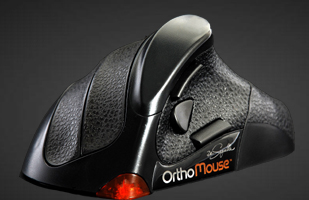
 |
|---|
The OrthoMouse |
The Orthopedic Computer Mouse
|
Three buttons form a set that replaces the scrolling wheel of conventional mice, with all the advantages and merits of the position of function. Center Button (third button of the mice): used for rolling selection in some programs. Click once: an icon appears which, when displaced, moves the screen upwards, downwards, to the left or to the right. The longer the distance traveled, the quicker the rolling. Performs the same function that clicking on the scroll wheel. Click a second time: the icon disappears. Top Button: used for upward vertical rolling.
Click once: the screen moves upwards.
Click twice or more, and hold: the screen moves upwards, continuously, at a speed
proportional to the number of clicks – 5 clicks reaches the fastest scrolling). Bottom Button: downwards vertical rolling:
Click once: the screen moves downwards.
Click twice or more, and hold: the screen moves downwards, continuously, at a speed
proportional to the number of clicks – 5 clicks reach the fastest scrolling).
Release: the movement ceases.
Why it is good for you.
Well, you have certainly heard that there is one “small” difference between the hands of monkeys and humans that seems to have played an enormous role in the evolution of the human race. This difference is precisely the position of the thumb in relation to the other fingers of the hand: monkeys have the thumb shorter than human’s, their thumb is parallel to the other fingers and in retroposition (Which means in adduction and moved to the back with respect to the metacarpus), whereas we have it in opposition to the other fingers, so that the pulp of the thumb is capable of touching the pulp of each and every one of the other fingers, and this adds immensely to our ability to hold things, as well as to the precision of movements we can achieve with our hands. This reference says it all: “The hand without a thumb is at worst, nothing but an animated fish-slice and at best a pair of forceps whose points don't meet properly. Without the thumb, the hand is put back 60 million years in evolutionary terms to a stage when the thumb had no independent movement and was just another digit. One cannot emphasize enough the importance of finger-thumb opposition for human emergence from a relatively undistinguished primate background. Through natural selection, it promoted the adoption of the upright posture and bipedal walking, tool-using and tool-making that, in turn, led to enlargement of the brain through a positive feed-back mechanism. In this sense it was probably the single most crucial adaptation in our evolutionary history... Opposition is a movement by which the pulp surface of the thumb is placed squarely in contact with – or diametrically opposite to – the terminal pads of one or all of the remaining digits.”[i] John Napier. Hands , Chapter. three “Function of the hand". Opposition. pg.55. Princeton University Press. 1993. Actually in most existing mice, the thumb remains at all times straight and parallel to the other fingers, as well as very close to the index finger (Adduction). This set of positions are known as “adduction and retroposition of the thumb” and are classified in orthopedics as a "high risk positions". It is quite adequate to monkeys hands. In humans, however, it mandatorily leads to DeQuervain’s syndrome and other “plagues” like arthrosis of the thumb, just to name another one. Now, if your search for the therapy recommendation for people with such diseases, you will often find that immobilization of the hand may help. This suggested immobilization puts the hand, fingers and forearm in the “position of function”, which is precisely the concept behind the Orthomouse: that your hand remains relaxed and in the "position of function" at all times. The Orthomouse can help in healing. The thumb buttons of the Orthomouse have a special leverage effect in their mechanics that means you will need only 1/3 (one third) of the force you usually need to click a button. They are the lightest click ever on a mouse, lighter even than the Orthomouse’s two main buttons. Additionally, there is one specific aspect of the position of function that never ceases to amaze us: ‘This so-called position of function,’ says White (1960) in a humorous manner, ‘has all the wisdom of parking a bulky old car with a weak battery on a hill. From this position, it is easy to get started again.’ 0 Raoul Tubiana, M.D, The Hand, Vol. II, chapter 53, “The ‘Position of Function,’ ” pg. 497, 1985. Which means not only is it a position of equilibrium of all muscles, tendons and joints (which in itself is already great). It is also the position that requires minimum effort in starting movement of any of its parts (fingers, hand, forearm…)!!! And of course it preserves full control, because the index and thumb are in the “pincer position” – they are not making any force at all, they are in equilibrium and supported by the Orthomouse, yet they are capable of the greatest precision possible to the human hand.
|
|---|